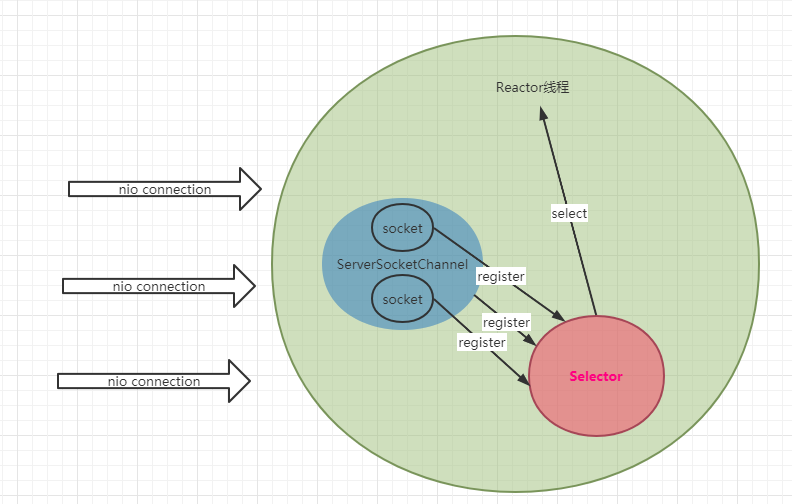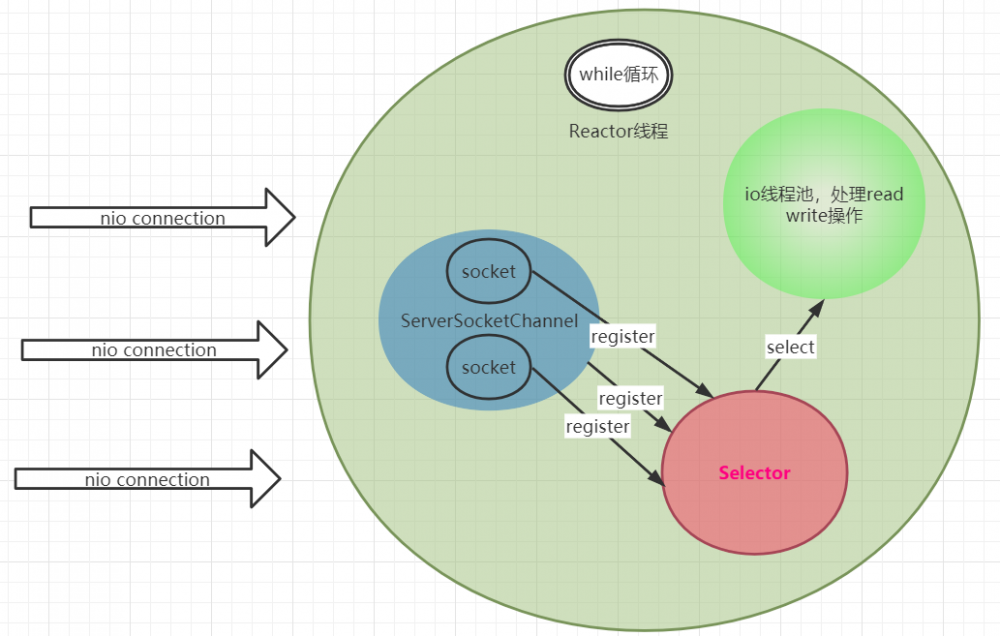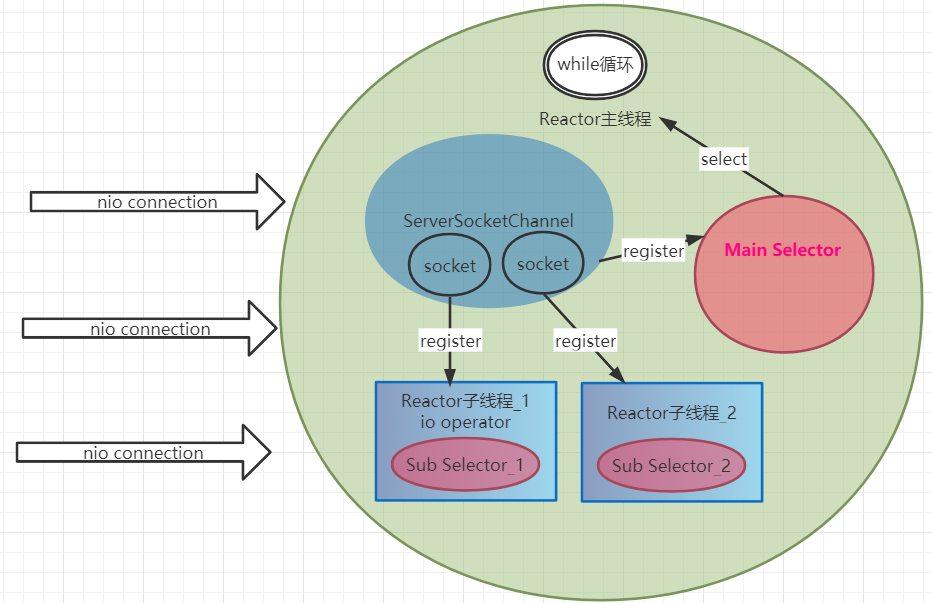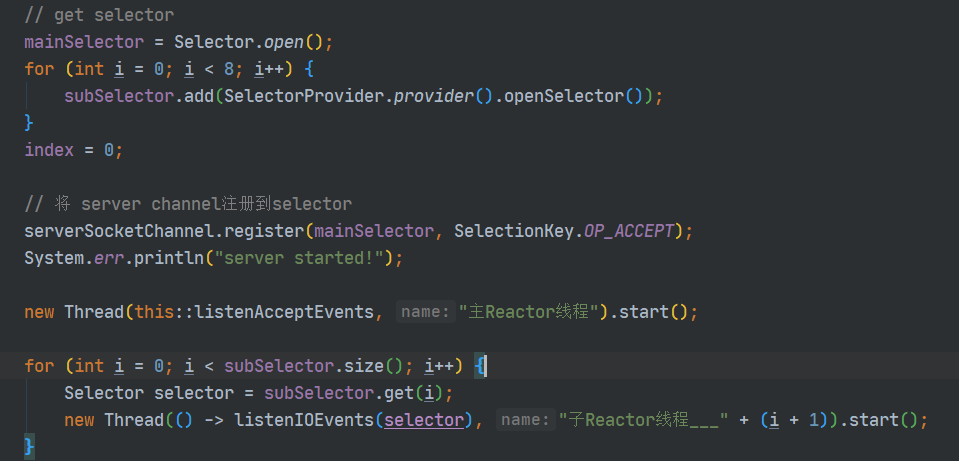netty极简教程(五):Netty的Reactor模型演进及JDK nio聊天室实现
介绍了jdk实现nio的关键Selector以及SelectableChannel,了解了它的原理,就明白了netty为什么是事件驱动模型:(netty极简教程(四): Selector事件驱动以及SocketChannel 的使用 ,接下来将它的使用更深入一步, nio reactor模型演进以及聊天室的实现;
示例源码: github.com/jsbintask22…
nio server
对于io消耗而言,我们知道提升效率的关键在于服务端对于io的使用;而nio压榨cpu的关键在于使用 Selector 实现的 reactor 事件模型以及多线程的加入时机:
单线程reactor模型

省略Selector以及ServerSocketChannel的获取注册; 将所有的操作至于reactor主线程
while (true) { // 1
if (selector.select(1000) == 0) { // 2
continue;
}
Iterator<SelectionKey> selectedKeys = selector.selectedKeys().iterator(); // 3
while (selectedKeys.hasNext()) {
SelectionKey selectionKey = selectedKeys.next();
SelectableChannel channel = selectionKey.channel();
if (selectionKey.isAcceptable()) { // 4
ServerSocketChannel server = (ServerSocketChannel) channel;
SocketChannel client = server.accept();
client.configureBlocking(false);
client.register(selector, SelectionKey.OP_READ, ByteBuffer.allocate(CLIENT_BUFFER_SIZE));
String serverGlobalInfo = "系统消息:用户[" + client.getRemoteAddress() + "]上线了";
System.err.println(serverGlobalInfo);
forwardClientMsg(serverGlobalInfo, client); // 5
} else if (selectionKey.isReadable()) {
SocketChannel client = (SocketChannel) channel;
SocketAddress remoteAddress = null;
try {
remoteAddress = client.getRemoteAddress();
String clientMsg = retrieveClientMsg(selectionKey);
if (clientMsg.equals("")) {
return;
}
System.err.println("收到用户[" + remoteAddress + "]消息:" + clientMsg);
forwardClientMsg("[" + remoteAddress + "]:" + clientMsg, client); // 6
} catch (Exception e) {
String msg = "系统消息:" + remoteAddress + "下线了";
forwardClientMsg(msg, client);
System.err.println(msg);
selectionKey.cancel(); // 7
try {
client.close();
} catch (IOException ex) {
ex.printStackTrace();
}
}
}
selectedKeys.remove();
}
}
复制代码
SelectionKey Accept Read
读取以及广播消息方法如下:
SocketChannel client = (SocketChannel) selectionKey.channel();
ByteBuffer buffer = (ByteBuffer) selectionKey.attachment();
int len = client.read(buffer);
if (len == 0) {
return "";
}
buffer.flip();
byte[] data = new byte[buffer.remaining()];
int index = 0;
while (len != index) {
data[index++] = buffer.get();
}
buffer.clear();
return new String(data, StandardCharsets.UTF_8);
复制代码
Set<SelectionKey> allClient = selector.keys();
allClient.forEach(selectionKey -> {
SelectableChannel channel = selectionKey.channel();
if (!(channel instanceof ServerSocketChannel) && channel != client) { // 1
SocketChannel otherClient = (SocketChannel) channel;
try {
otherClient.write(ByteBuffer.wrap(clientMsg.getBytes(StandardCharsets.UTF_8)));
} catch (IOException e) {
e.printStackTrace();
}
}
});
复制代码
从Selector上获取所有注册的Channel然后遍历,如果不是ServerSocketChannel或者当前消息的Channel,就将消息发送出去.
以上,所有代码放在同一线程中,对于单核cpu而言,相比于bio的 Socket 编程,我们主要有一个方面的改进
accept read
而对于多核cpu而言,Selector虽然能够有效规避accept和read的无用等待时间,可是它依然存在一些问题;
select
多线程reactor模型

基于上面的单线程问题考虑,我们可以将io操作放入线程池中处理:
- 将accept事件的广播放入线程池中处理
- 将read事件的所有io操作放入线程池中处理
if (selectionKey.isAcceptable()) {
ServerSocketChannel server = (ServerSocketChannel) channel;
SocketChannel client = server.accept();
client.configureBlocking(false);
client.register(selector, SelectionKey.OP_READ, ByteBuffer.allocate(CLIENT_BUFFER_SIZE));
String serverGlobalInfo = "系统消息:用户[" + client.getRemoteAddress() + "]上线了";
System.err.println(serverGlobalInfo);
executorService.submit(() -> { // 1
forwardClientMsg(serverGlobalInfo, client);
});
} else if (selectionKey.isReadable()) {
executorService.submit(() -> { // 2
SocketChannel client = (SocketChannel) channel;
SocketAddress remoteAddress = null;
try {
remoteAddress = client.getRemoteAddress();
String clientMsg = retrieveClientMsg(selectionKey);
if (clientMsg.equals("")) {
return;
}
System.err.println("收到用户[" + remoteAddress + "]消息:" + clientMsg);
forwardClientMsg("[" + remoteAddress + "]:" + clientMsg, client);
} catch (Exception e) {
String msg = "系统消息:" + remoteAddress + "下线了";
forwardClientMsg(msg, client);
System.err.println(msg);
selectionKey.cancel();
try {
client.close();
} catch (IOException ex) {
ex.printStackTrace();
}
}
});
}
selectedKeys.remove();
}
复制代码
在 1与2处,我们加入了线程池处理,不再在reactor主线程中做任何io操作。 这便是reactor多线程模型
虽然模型2有效利用了多核cpu优势,可是依然能够找到瓶颈
- 虽然广播消息是在一个独立线程中,可是我们需要将Selector上注册的所有的channel全部遍历,如果Selector注册了太多的channel,依旧会有效率问题
- 因为Selector注册了过多的Channel,所以在进行select选取时对于主线程而言依旧会有很多的循环操作,存在瓶颈
基于以上问题,我们可以考虑引入多个 Selector ,这样主Selector只负责读取accept操作,而其他的io操作均有子Selector负责,这便是多Reactor多线程模型
多Reactor多线程模型

基于上面的思考,我们要在单Reactor多线程模型上主要需要以下操作
子Selector
基于以上,会增加一个子Selector列表,并且将原来的accept以及读取广播分开; private List<Selector> subSelector = new ArrayList<>(8); 定义一个包含8个子selector的列表并进行初始化

如图,分别开启了一个reactor主线程,以及8个子selector子线程,其中,主线程现在只进行accept然后添加至子selector
while (true) {
if (mainSelector.select(1000) == 0) {
continue;
}
Iterator<SelectionKey> selectedKeys = mainSelector.selectedKeys().iterator();
while (selectedKeys.hasNext()) {
SelectionKey selectionKey = selectedKeys.next();
SelectableChannel channel = selectionKey.channel();
if (selectionKey.isAcceptable()) {
ServerSocketChannel server = (ServerSocketChannel) channel;
SocketChannel client = server.accept();
client.configureBlocking(false);
client.register(subSelector.get(index++), SelectionKey.OP_READ, // 1
ByteBuffer.allocate(CLIENT_BUFFER_SIZE));
if (index == 8) { // 2
index = 0;
}
String serverGlobalInfo = "系统消息:用户[" + client.getRemoteAddress() + "]上线了";
System.err.println(serverGlobalInfo);
forwardClientMsg(serverGlobalInfo, client);
}
}
selectedKeys.remove();
}
复制代码
- 将新连接注册至从Selector.
- 如果当前的selector已经全部添加了一遍则重新从第一个开始
所有的从Selector只进行io操作,并且本身已经在异步线程中运行
while (true) {
if (subSelector.select(1000) == 0) {
continue;
}
Iterator<SelectionKey> selectedKeys = subSelector.selectedKeys().iterator();
while (selectedKeys.hasNext()) {
SelectionKey selectionKey = selectedKeys.next();
SelectableChannel channel = selectionKey.channel();
if (selectionKey.isReadable()) {
SocketChannel client = (SocketChannel) channel;
SocketAddress remoteAddress = null;
try {
remoteAddress = client.getRemoteAddress();
String clientMsg = retrieveClientMsg(selectionKey); // 1
if (clientMsg.equals("")) {
return;
}
System.err.println("收到用户[" + remoteAddress + "]消息:" + clientMsg);
forwardClientMsg("[" + remoteAddress + "]:" + clientMsg, client); // 2
} catch (Exception e) {
String msg = "系统消息:" + remoteAddress + "下线了";
forwardClientMsg(msg, client);
System.err.println(msg);
selectionKey.cancel();
try {
client.close();
} catch (IOException ex) {
ex.printStackTrace();
}
}
}
selectedKeys.remove();
}
复制代码
- 读取消息
- 广播消息 启动server,并且打开三个客户端:



netty线程模型思考
事实上,在netty的线程模型中,与上方的 多Reactor多线程模型类似 ,一个改进版的多路复用多Reactor模型; Reactor主从线程模型
- 一个主线程不断轮询进行accept操作,将channel注册至子Selector
- 一个线程持有一个Selector
- 一个子Selector又可以管理多个channel
- 在断开连接前,一个channel总是在同一个线程中进行io操作处理
基于以上思考,我们将在后面在netty源码中进行一一验证。











![[HBLOG]公众号](https://www.liuhaihua.cn/img/qrcode_gzh.jpg)

